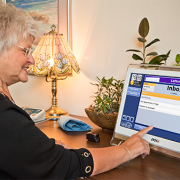Kiplinger Showcases GrandCare Technology to Help Seniors Remain in Their Homes
Kiplinger, a national financial news magazine, recently gave a shout out to GrandCare Systems in an article called “Technology Helps Seniors Remain at Home.” GrandCare was highlighted as a device to help seniors remain independent in their own homes.
“Most of us want to remain at home as we get older, but safety and health issues and social isolation can interfere with that plan.” The article praises GrandCare for being a technology that addresses both of those issues, and that enables seniors “to stay put indefinitely.”
The author specifically mentions GrandCare’s comprehensive health and wellness features. Using home health devices, such as blood pressure monitors, weight scales, glucometers, and pulse oximeters, seniors can take their readings at home, and those readings are automatically (and wirelessly) transmitted and recorded to the GrandCare System in the residence. Family members and caregivers can login in remotely to view the readings at any time, and identify trends. They can also set rules to receive email, phone, or text notifications whenever a reading falls outside of a chosen range, or whenever the senior forgets to take a reading. And they can take printouts of the readings with them to doctor appointments.
The article also commended GrandCare’s socialization and communication features.
“With an interactive touch screen from [GrandCare] Systems, you can look at a photo of a grandson’s Halloween costume or a video replay of his baseball home run. You can listen to music, play word games, read the news or surf the Internet. No need to know how to use a computer.”
The article quotes GrandCare customer Randall Schafer, 61, of Houston, whose 90-year-old mother has a GrandCare system in her home. Schafer said that he and his mother especially love the video chat feature of her system.
“‘My mom is in love with our dog, Daisy,’ Schafer says. Her ‘face lights up’ when she sees the schnauzer, he says.” The GrandCare system makes it so easy to do, that she can simply push a button to start the video chat.



